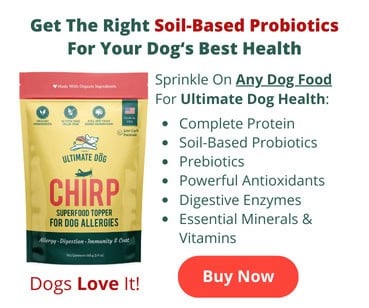If you’ve ever owned a dog that suffers from allergies, you already know how distressing and debilitating the symptoms can be.
Depending on the cause and type of reaction being experienced, natural remedies for your dog’s allergies can be useful. Some work best on their own while others should be given as a complementary treatment to medications and procedures done by your vet.
Allergies can range in severity from minor itching or digestive upset to major hair loss and even anaphylaxis. Most commonly, allergies are caused by environmental triggers or relate to dietary factors.
How severe an individual dog’s allergies are may vary by the season and even by their breed. And because allergies often present themselves in different ways depending on the dog, figuring out if your dog has allergies isn’t always straight forward.
Does Your Dog Actually Have an Allergy?
Before you consider which natural remedy to use for your dog’s allergies, you first have to establish if your dog is indeed suffering from an allergy. The symptoms of allergies can often be similar to those caused by other conditions.
Of course, for prolonged or severe allergic symptoms, we would always recommend consulting with your vet. If you are keen to have a more natural approach to treatment, then you should visit a certified holistic vet. This kind of vet combines conventional treatments with alternative therapies.
Allergy symptoms can include skin irritation, bacterial infections, a runny nose, sneezing, respiratory issues, and gastrointestinal issues.
Allergies are most commonly triggered by environmental factors such as pollen, dust, or even certain products used within the home. Parasites living on the skin, such as fleas, are also a frequent cause of canine allergies. Dogs can even have food allergies and may be reacting to an ingredient in their diet.
There are a number of tests that can be carried out by your vet or through at-home kits that claim to help diagnose what is causing an allergy. However, there have been no scientific studies to validate the accuracy of these tests. In some cases these tests may even prove to be misleading, providing flawed results. A standard method for testing is through saliva, and a study published in 2019 by the Veterinary Journal illustrates that this method of testing is not completely reliable.
The majority of vets concur that the most effective way of establishing what is causing an allergy is through a process of elimination, particularly when it comes to food allergies.
Food Allergies and Exclusion Diets
If your dog has an allergy that is triggered by food, you could completely eradicate the need for the use of any medical intervention or natural remedies. By conducting an elimination diet, it is possible to establish what foods are triggering an allergic reaction. These can then be excluded from their feeding regime going forward.
This process can often be lengthy and complicated, but being strict and sticking with it can result in a much happier and healthier dog in the long run.
You should select a simple diet with a novel protein and carbohydrate source that your dog has never eaten before. This should be fed for at least 8 to 12 weeks. It is essential that you pick a food with ingredients your dog has never eaten before, that the total ingredients are limited, and that you do not feed any other treats or table scraps during this period. Too many components make it harder to identify potential allergens. Feeding this elimination diet for just a couple of weeks is not enough, either. Your dog needs time for the original allergens to completely leave their system.
After 8 to 12 weeks, if your dog’s symptoms have subsided, then you can gradually introduce new ingredients one at a time.
Once you have completed the elimination diet, ensure that you are feeding a fully balanced diet that has an appropriate blend of nutrients, vitamins, and minerals. If you have gone down the home-cooked route, we recommend seeking advice from a board-certified veterinary nutritionist.
Management of Environmental Allergies
Veterinary medications and natural remedies can help to relieve the symptoms of environmental allergies. But, it can also be beneficial to try to manage your dog’s exposure to the triggers.
Some allergies can be seasonal and triggered by the same substances that cause many human allergies, such as pollen or grass. Walking your dog in areas that have less dense grass and plant growth can help minimize symptoms. It can also be helpful to bathe your dog after their walk to remove as much pollen as possible. In some severe cases, owners may choose to use a bodysuit or t-shirt. This can minimize the contact your dog’s skin has with the allergen.
If you believe it’s a household product that’s causing the reaction, you need to identify exactly what the culprit is. This can require a bit of detective work.
Any new symptoms are likely the result of a recent change in homecare products, such as a new detergent or cleaning spray. If you haven’t kept up with your dog’s regular flea treatments, this can also lead to worsening allergy symptoms. Parasites are a common skin allergy trigger and the more out of control the infection gets, the worse your dog’s itching and irritation will get, too. It is also important to keep your house clean. Regular vacuuming to prevent a build-up of dust can be a simple but effective step.
For some severe environmental allergies, your vet may suggest immunotherapy. During immunotherapy, a small amount of the known allergen is injected into your dog on a regular schedule over a period of time. The hope is that the dog becomes desensitized to the allergen after repeated exposures in controlled doses. This is not a guaranteed solution, though, and success rates can vary greatly.
Can Natural Remedies for Dog Allergies Be Beneficial?
Natural remedies can be beneficial when used alongside more conventional treatment. If you do choose a natural treatment, make sure that it’s safe for dogs, you use it correctly, and administer it in the right dose. In some cases, natural remedies can even be used in place of veterinary prescribed drugs. This avoids the risk of possible long term side effects and costly prescriptions.
Always make sure you seek advice from your vet and check that the remedy is safe to use with any other medications your dog is on. If your dog’s reaction gets worse, that’s a sign that the remedy is not working as intended and should be stopped right away.
Below, are some common natural remedies that may help provide relief for dogs with allergies.
Apple Cider Vinegar
If your dog suffers from seasonal allergies triggered by pollen, then an apple cider vinegar (ACV) solution can be useful for cleansing irritated skin and may offer your dog some itch relief. It also has powerful antibacterial and antifungal properties.
Create a half and half mixture of ACV and water and put it into a spray bottle to spritz over your dog’s body. Alternatively, you can focus on certain areas that need it most, such as your dog’s paws and around the groin and ear areas. You can also use it to rinse pollen and dust from your dog’s paws after their walk.
You should never use this type of solution on open or raw sores. If your dog has very sensitive skin, you may consider treating a small area to see how they react to it before applying it to their entire body.
Apple cider vinegar does have a rather strong and bitter smell. After your dog has had an ACV soak, you may want to give them a further rinse to reduce the pungent odors.
ACV can also be gradually introduced into your dog’s diet and may help relieve mild gastrointestinal problems and improve digestion. While it is not a cure for food allergies, apple cider vinegar may help relieve some symptoms.
Baking Soda
Baking soda is a surprisingly effective, inexpensive, and environmentally friendly remedy. By giving your dog a baking soda bath you can often avoid the use of harsh chemicals and help to reduce itching and inflammation.
You can give your dog a “dry bath” by dusting baking soda directly onto their coat and then brushing it out. Alternatively, you can create a shampoo by mixing two tablespoons of baking soda with three cups of water. Be careful that it doesn’t get into your dog’s eyes.
Or, you can create a paste using equal parts baking soda and water. Apply this to particularly irritated areas. Ideally, the paste should be left on for at least five or ten minutes.
Coconut Oil
Coconut oil has grown in popularity for humans and dogs alike and is often added to food or used as a topical treatment for a wide range of doggy health concerns.
Despite its widespread use, there are very few comprehensive studies that have been conducted to confirm its efficacy. If used in moderation, however, it is unlikely to cause any problems and it could offer some benefits.
When applied topically to the skin, coconut oil can provide relief from inflammation and itchiness.
It can also be added to your dog’s diet to help soothe digestive upset and inhibit yeast production. You should always introduce it very gradually to avoid causing runny stools or worse. A quarter to a half teaspoon per day should be enough.
Always make sure that you select a high quality, organic, food-grade version as this type has the highest concentration of beneficial lauric acid.
Herbs
Making up a tincture solution using certain dried herbs can offer relief from itchiness and inflammation. Lavender, rosemary, peppermint, thyme, and chamomile are all herbs that are safe to use with dogs and that help to relieve the topical symptoms that allergies can cause.
Dried herbs soaked in warm water can be applied directly to the skin. Alternatively, you could soak a cloth, towel, or even a bodysuit in the solution and press it to your dog’s body where needed.
Some people choose to use the herbs in an essential oil form. These should never be administered in an undiluted state as they are too potent and can cause more harm than good. You can use coconut or olive oil to dilute them. It’s a good idea to use essential oils in limited amounts first to see how your dog will react.
Chamomile tea bags or even green tea can be soaked in warm water to create a soothing bath for your dog.
Some other herbs that can help with itching and inflammation include calendula, sage, comfrey, and licorice root.
Oatmeal
Oatmeal is known for its anti-inflammatory properties. Giving your dog an oatmeal bath or rinse can help to reduce itching and soothe inflammation caused by allergies.
You can even use any sugar-free, natural oats that you have in your cupboard. Simply grind them up and boil them in water. Suspending the ground oatmeal in a liquid solution allows it to be more easily absorbed. It can then be applied to the skin, left on for a few minutes, then rinsed off. Colloidal oatmeal shampoos specially formulated for dogs are also available for purchase.
If your dog has a yeast infection on their skin, you shouldn’t use this type of carbohydrate-based solution as the sugars can encourage more yeast growth.
Omega 3 Fatty Acids
Studies have shown that omega 3 fatty acids, particularly EPA and DHA, can have a beneficial impact for all dogs. They are believed to reduce inflammation, promote good gastrointestinal health, and may even help with things like heart disease and kidney function.
Most high-quality commercial dog foods contain EPA and DHA. However, they’re often included in quantities that aren’t high enough to offer noticeable benefits.
As a result, many owners will add omega 3 fatty acid supplements to their dog’s diet. This may help reduce the intensity of allergic reactions and can improve your dog’s skin and coat health.
The amount needed will vary depending on the size of your dog and the quality of the supplement. Care should be taken not to give too much as this can have adverse effects.
Supplements are most commonly given in the form of fish oil, such as salmon oil. Some owners choose to give flaxseed oil but these omega 3 fatty acids are not as easily transformed into DHA and EPA. This is why fish oils are regarded as more effective for use in dogs.
Quercetin
Quercetin is a naturally occurring plant pigment. It can be found in a wide variety of foods and plants including apples, green tea, berries, and St John’s wort. But it is most often taken as a concentrated supplement. It’s commonly combined with bromelain to increase the absorption rate into the body.
Studies have shown that quercetin works well as a natural antihistamine and can reduce inflammation in people as well as dogs.
While this is not a supplement that has been approved by the FDA for use in dogs yet, it is generally viewed as being relatively safe. It can work well, providing you don’t use too high of a dose. You should always consult with your vet before administering it, particularly if your dog has kidney issues or is on medication with blood-thinning properties.
Witch Hazel and Aloe Vera
For dogs that have hot spots and sores, products with astringent properties, like witch hazel and aloe vera, can be useful when used topically. They both promote healing, reduce inflammation, and provide soothing relief.
If your dog has dry or flaky skin, these harsher products would be best avoided as they could dry the skin out further. You should also make sure that you select a gel that does not contain alcohol. Alcohol tends to sting and can even burn the skin. If you have an aloe vera plant at home, you can even use one of the leaves to make a gel of your own.
Helping Your Dog Overcome Allergy Symptoms
While curing your dog of allergies often involves a multistep process like an elimination diet, removing allergens from your home, or immunotherapy, helping your dog find some relief from allergy symptoms is possible with the help of these simple natural remedies.
Taking a more holistic approach allows you to work in conjunction with your dog’s body to help their skin heal and reduce the reactivity of their immune system. Unlike prescription medications, most of these remedies don’t have any nasty side effects when used correctly. And best of all, many of them have benefits beyond treating allergies.
Whether you choose to treat with a dietary supplement like omega 3s or quercetin or take a topical approach to soothe your dog’s allergy symptoms, your dog is sure to appreciate the help. You may even consider combining treatments to provide extra relief while you work with your vet or veterinary nutritionist to nail down exactly what is causing your dog’s allergies.
Once you have pinpointed what is affecting your pooch, you can continue to use many of these natural remedies to help your dog heal after the allergen has been removed. With that dedication, your dog is sure to be back to their happy, healthy, itch-free self in no time.
Sources
L. Udraite Vovk, A. Watson, W.J. Dodds, C.J. Klinger, J. Classen, R.S. Mueller (2019, July). Testing for food-specific antibodies in saliva and blood of food allergic and healthy dogs. The Veterinary Journal. https://www.sciencedirect.com/science/article/pii/S1090023318307780
John E. Bauer, DVM, Ph.D., DACVN (2011, December). Therapeutic use of fish oils in companion animals. Journal of the American Veterinary Medical Association. https://www.dog-swim.com/files/en/user/cms/JAVMA_fish_oil_2011.pdf
Catherine E. Lenox, DVM, Diplomate ACVN. Role of Dietary Fatty Acids in Dogs & Cats. Retrieved from https://todaysveterinarypractice.com/role-of-dietary-fatty-acids-in-dogs-cats/





Leave a Comment